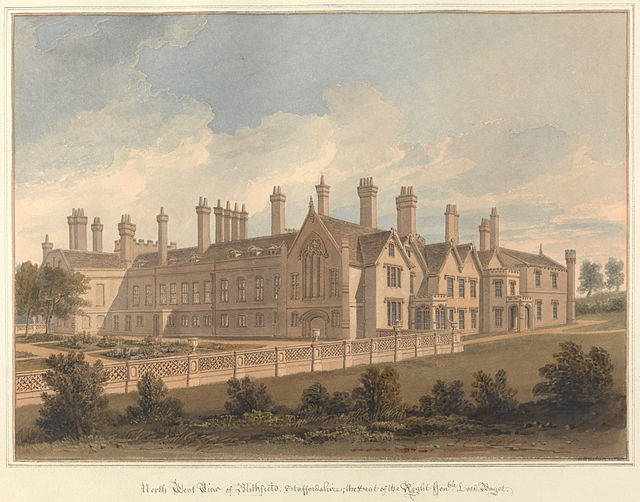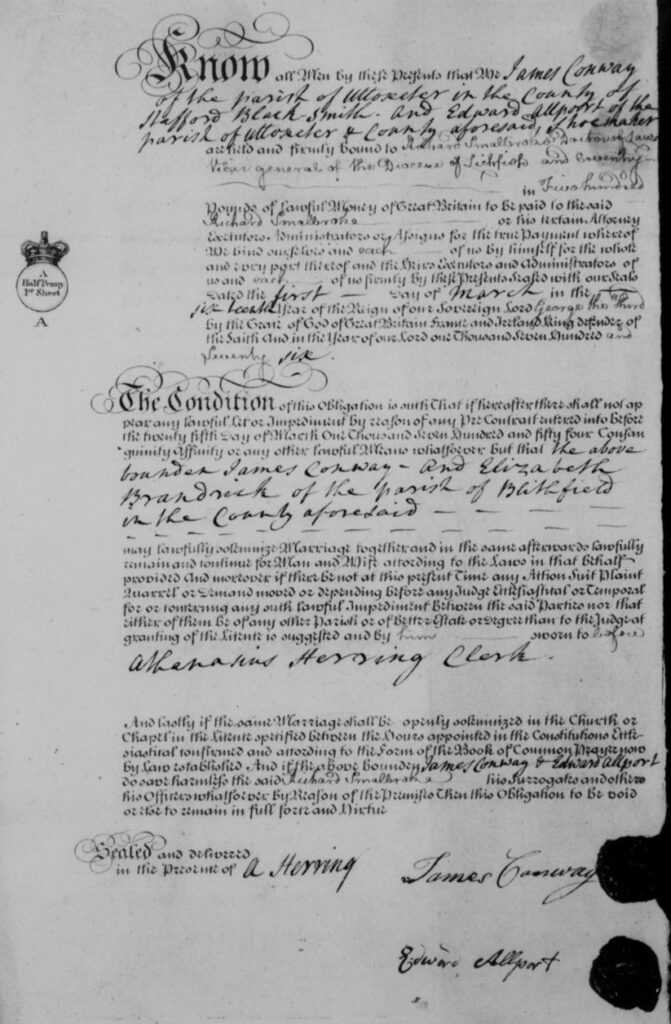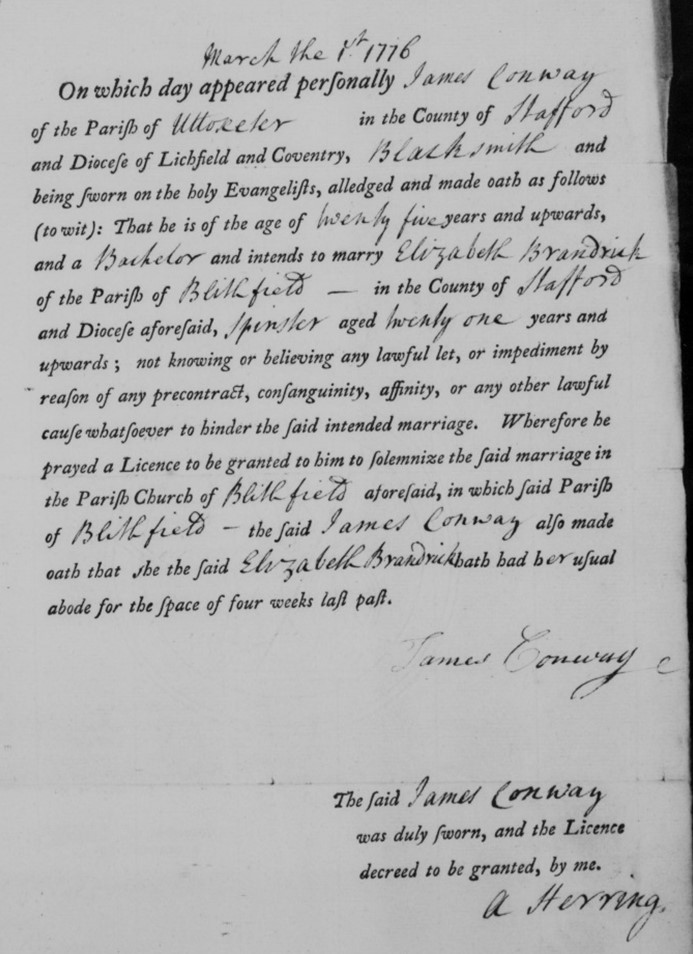By Sheila Cochrane nee Conway
I started looking into my family history back around the year 2000. My dad’s surname was Conway and he came from a small village called Armitage in Staffordshire. I also knew that his father, Arthur, had died when my dad was 5 years old; we have a nice photo of him sitting in the garden. Arthur Conway was born in 1885 to George Conway (born 1843) and his wife Mary Ann Mountford. George married twice as his first wife Eliza Dainty died in childbirth, and he ended up with 16 children. I knew all of this was correct as I still have the family bible which has the names handwritten in it. There was also the name Charlotty, her date of birth and the names of her children including George, so by then I had managed to get back to 1812 when Charlotty was born. I was very thankful and pleased that my ancestors had written all this down as it gave me a real link to them.
I then had to start researching properly so I joined Ancestry and started filling in their little rectangle boxes. I discovered that Charlotty was actually Charlotte Wood who had married a John Conway (born 1810) and that they were on the Census records living on Old Road in Armitage.
We had visited my granny, Elizabeth Sarah Morecroft, my dad’s mother, quite a few times; she still lived in Armitage and my dad used to take me to see his favourite places. I loved the huge water meadows down near the River Trent and the many large dragonflies and butterflies that seemed to be everywhere. It was very beautiful, quiet and soothing, just watching the tall reeds swaying in the breeze, the skylarks soaring and singing their uplifting songs. We visited the Old Road which backed onto the “cut”. I asked my dad why he called it a cut and he said “well it’s the canal and it was cut out by men using their hand shovels. Some men – called navvies – could shift 12 cubic yards of earth a day, which is the same as digging a trench 3ft wide, 3ft deep and 35ft long in a day.” I was totally amazed by this. On the way back we came near the rear yard at the back of the Armitage Shanks pot bank; I was fascinated by the conveyor high up on the wall with a long line of sinks and toilets travelling along it, each one dropping off the end with a massive crash onto the colourful pile beneath. It was totally out of keeping with the beautiful countryside all around us, but I have since found out that many of my family members worked there and I think this was the reason so many people stayed in Armitage, or moved there, because of the employment.
Over many years I continued my family research and I found that John Conway (born 1810) was the son of another John (born 1783) and that further back again there was a James Conway born in 1751 and he had married an Elizabeth Brandrick who was born in 1754 in Blithfield, Staffordshire, 7.5 miles southwest of Uttoxeter and 5 miles north of Rugeley. It is a very small place. I decided to look more closely at this information and found out that there is a very large old hall there owned by landed gentry. The Bagot family have owned Blithfield Hall since the late 14th century.

I decided to join Find My Past and uploaded my family tree onto their website. I started to investigate their handwritten records and found them amazing. I do not think those ancient scribes had the faintest idea that we would be scrutinising their handwriting all these years later. I put in James Conway, born 1751, and Elizabeth Brandrick as I knew the date of their marriage and it offered me the option to view the original image. I opened it up and was totally amazed to see a most wonderful document in front of me; it was written in Olde English and was almost impossible to read. It said James Conway was a blacksmith in Uttoxeter and mentioned a substantial amount of money, £500.00


My immediate thought was that it was a huge amount of money back in 1776 and maybe it was a dowry but, as the names mentioned were not Elizabeth’s surname of Brandrick, I discounted that. It said that the money would have to be paid by James Conway and Edward Allport – who was a shoemaker in Uttoxeter – to the Vicar of Lichfield, one Richard Smalbroke Doctor of Law. I was mystified and decided I needed help with this.
I contacted Burntwood Family History Society and asked if they could help but they did not know what the sum was for either, no one having seen anything like it. A founder member suggested that it would be a good idea to ask Staffordshire Record Office and provided a contact link. I asked the Record Office if they could help and the answer came back the very next day, that the document was a Marriage Bond.
Reply from Staffordshire Record Office
Dear Mrs Cochrane
The images you have sent are of marriage bonds. This is not the licence but a document that had to be drawn up in order to obtain the licence. The licence itself would have been given to the couple to take to the church. Basically, the bond is a promise by the people listed that there is no reason or impediment why the couple named cannot be lawfully married. If it turned out that there was a reason, e.g. if one of them was already married, then they would have to forfeit the sum of money mentioned in the bond. Bonds can be quite interesting as the people swearing there is no impediment can often be a family friend or relative or some one of the same trade or station in life.
So how incredible was that and what a lot of money! I wondered how much James would have earned back then. It turns out 7 shillings and 6 pence per week was the average wage for a labourer but I guess James would have earned a bit more being a blacksmith. However, if my Maths is correct, it would have taken James at least 25 years to pay that much back, indeed longer as he would only have been able to spare some of his wages. I decided that James must have been very much in love to have considered putting himself in such jeopardy. Not only that but Edward Allport, a shoemaker, was willing to trust James to that extent, he must have been an exceptional friend. I could also picture James and Elizabeth going off to St. Leonard’s Church in Blithfield with their much-prized Marriage Licence to get wed. Awww bless!
Over the next week I could not stop thinking about this huge amount of money, and about Edward Allport, so I decided to find out more about the family in general. I tried using Find my Past and Ancestry but without success. I had almost given up but then I went onto the Mormon’s Family Search website. It is an amazing site and many people from all over the world add their family to the Worldwide Tree. I looked up my Conway’s and got to James and then swapped to Elizabeth and found her father Richard Brandrick (born 1713). Lots of people had supplied all of Richard’s children to the site and I was looking at the various names when I could not believe my eyes. There, right in front of me, was Edward Allport husband of Mary Brandrick. WOW! So, Elizabeth had an elder sister, Mary, and she had married Edward Allport on 15 January 1770, which meant Edward was James’ brother in law. Now the whole thing made sense and I could see Mary and Elizabeth making plans for the wedding. I could imagine Mary saying to her husband that he had to help Elizabeth and James. I could even imagine the sisters going on a shopping expedition into Uttoxeter and going to try on shoes in Edward’s shop, eyeing up the blacksmith’s muscles whilst blushing and giggling a fair bit!
I mentioned earlier visiting my granny Elizabeth Sarah Morecroft and, while I was researching James and Elizabeth, I was in contact with my cousin Ann Morecroft, who had come up against a brick wall in her research trying to find our Morecroft family going back in Armitage and Hamstall Ridware during the 1780s and earlier. We had found them on the censuses including William Morecroft (born 1782). His wife, Jane, was recorded on the census return as having been born in Hamstall Ridware, Staffordshire. Ann had been searching on Ancestry, but nothing had come up. Once again, I decided to contact Burntwood Family History Society and they recommended the very accurate and highly detailed “blue books” produced by the Staffordshire Parish Registers Society (SPRS). They save an awful lot of hard work peering at microfiche readers or at the original registers (assuming you can get access to them) but you do need to check that a particular volume covers the dates you are researching. The Midlands Ancestors website provides access to some electronic versions and I was able to purchase the Hamstall Ridware church records (1598 to 1812) for just £4.00. We then scoured through the records to find anyone called Jane who had been baptised there around 1780 to 1800, Ann having previously found three possible candidates. I followed the lives of about 9 possible Janes and eventually discovered Jane Watho. I decided to look for her baptism and found her to be the daughter of Richard Watho. This spelling of the surname had caused problems with not being able to find the record as variations on the surname Watho include Waltho, Wathew, etc.
I looked up Richard’s baptism and found his parents were Samuel Watho and Dorothy Sherratt, born 1728 and 1737 respectively. I then went to find their marriage on 27 July 1758. When I pressed the button to view the original document, low and behold there before me was another Marriage Bond. It was almost identical to the one for James and Elizabeth and mentioned the same Richard Smalbroke, Vicar of Lichfield and Doctor of Law, but the amount of money was less, £100.00 this time. The other person mentioned is His Reverend Thomas White, York Master of Arts Surrogate. This marriage took place in 1758 in the Church of St. Michael and All Angels in Hamstall Ridware. I have been trying to find out more about the Reverend Thomas White, but as yet I haven’t been successful. It says he is a reverend so perhaps there is a list of church ministers in Staffordshire somewhere that will help me. I also wonder if these marriage bonds where unique to Staffordshire or did other counties have them as well.


I would like to sum up this article by saying that it’s obvious to me that the past is constantly all around us, separated from our present by the blink of an eye, it’s something intangible beyond our abilities to understand yet we may feel the link if we give the matter some quiet thought. We know it is there, yet we cannot see it, we give it a name – time. It makes our existence possible in which the present is but a fleeting illusion, gone the moment it arrives. We have the past to look back on and delve into: the Armitage I knew and visited as a young girl those 60 years ago, and the Armitage my dad knew in the 1920s and 1930s, has probably changed so much now that I would hardly recognise it. But, underneath the new and the modern lies the old infrastructure and the memories of the loved ones that have gone before us. Let us not forget that if they had not lived and loved we would not be here. I really enjoyed unearthing my ancestor’s story and I now have the future to look forward to, which will include a visit to the places mentioned and also to research into my DNA matches which is constantly revealing more and more. I wonder what else I will find out. I do know I have DNA matches from Uttoxeter and from people whose names are not (yet) included in my family tree. Exciting stuff!
